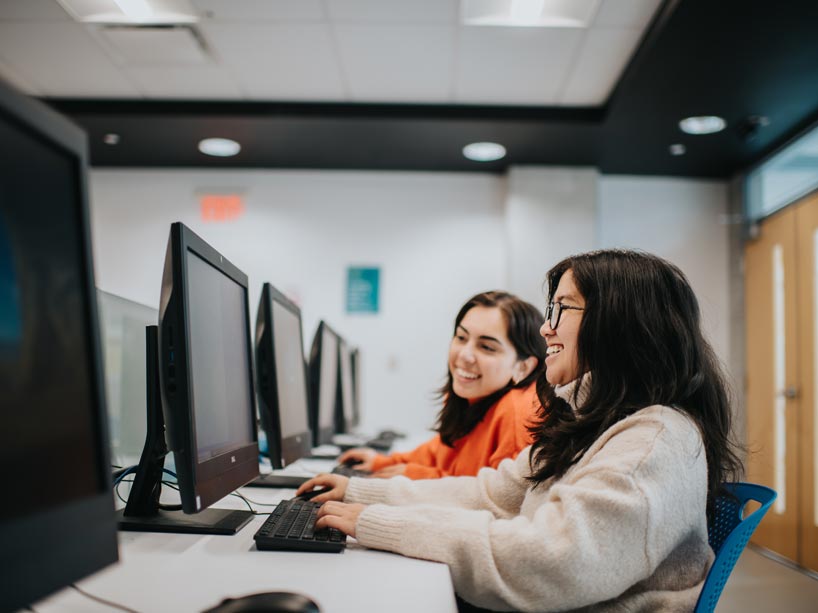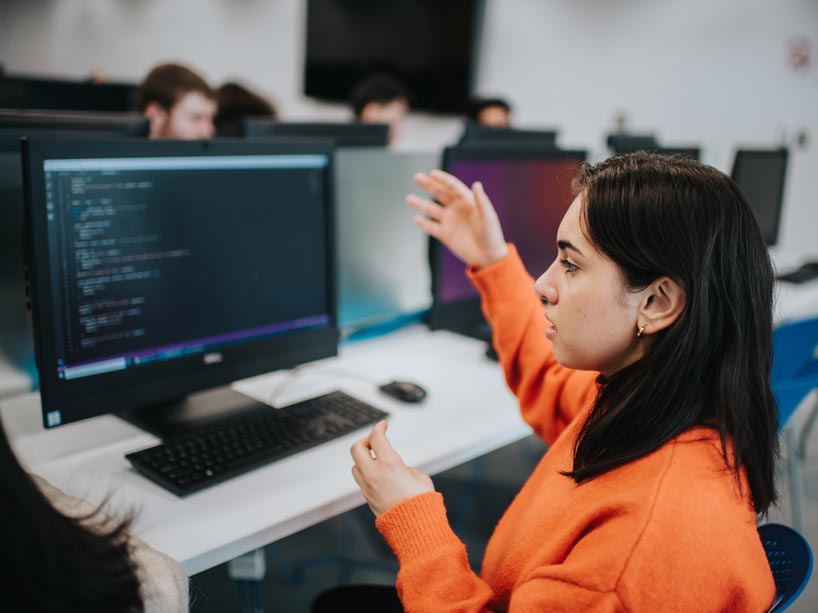Ryerson aims to close the gender gap in computer science

Nika Dariani (left) and Chloe Maceda see the value in having more women at the table when it comes to computer science. Photo credit: Alyssa Faoro.
According to Stats Canada, 88,131 post-secondary students were enrolled in mathematics and computer science (CS) programs across Canada in the 2017/18 academic year – of those, only 27 per cent were young women (external link) . And even that number should be taken with a grain of salt, because math programs typically have near-equal female enrolment, so aggregating the two together skews the data further.
Last year, Ryerson’s CS program saw almost 22 per cent enrolment rate for students who self-identified as female, up from 15 per cent the previous year. The remaining gap in gender parity prompted Dave Mason, CS chair, to launch a campaign called CS50 to reach gender equity in first-year applicants by the 2021-22 school year.
When the shift began
“If you go back to the early 80s, the numbers were higher, but by the mid-80s, women stopped doing CS and the numbers fell off fairly precipitously,” says Mason. He attributes the drop-off to the advent of personal computers, when computers were marketed to individual buyers and advertising targeted male users.
Chloe Maceda, a second-year CS student and vice-president of academics of WiCS (Women in Computer Science), says she noticed this in high school. “I think the idea that computer science is just coding or hacking is a barrier, but you take more than that. I went to an all-girl high school and we had a computer science class but it was a Grade 10 to 12 split because not that many girls were interested.” WiCS is a student group within the department that is increasingly trying to address the underrepresentation of women in CS and STEM fields.
“If we’re seeing numbers significantly below 50 per cent, something is wrong,” says Mason. “It’s a well-paying and interesting job, and it’s just being characterized differently to young women.” Mason says that significantly higher enrolment of males means that diverse perspectives are going unheard in software development. “I often say software is eating the world, and if we only have men making decisions, lots of good choices are not going to be available.”
What’s going to change
To shift enrolment, Mason says the department will be more inclusive with early offers to young women. In addition, the department will make changes to attract young women to join the program, including scholarships and a dedicated advocacy role. They are also looking at augmenting their existing mentorship program and Mason would like to create a meeting space for WiCS. “I’d like to provide more resources to WiCS so we can create a clearer path forward, for example with CAN-CWIC (a conference for women in CS),” says Mason.

Nika Dariani thinks that, with CS50, the department will benefit from new ways of doing things and wants to encourage other young women who have seen the field as a boys-only club. Photo credit: Alyssa Faoro.
Nika Dariani, a second-year CS student and vice-president of communications for WiCS believes these supports would interest more young women, and could do a lot to balance women in computer science. “I’m big on teamwork and seeing everyone's opinions,” says Dariani. “I was in a mock interview for co-op and seeing everyone’s opinions was so interesting – I was thinking about doing it one way and someone else thought of another solution. That was a group with one girl and four guys. If there were more women, we would definitely see new ways of doing things.”
Looking ahead
“I think that people are recognizing that computers are everywhere and almost everything you’re going to be doing can include computers,” says Mason. “Whatever your focus may be, having computer skills will probably facilitate that focus. And I’m hopeful that that message is landing everywhere. So to some degree we’re trying to accentuate this and create more opportunities.”
Both young women plan to keep the pace as far as outreach and enthusiasm goes. “I knew what the gender ratio was, but it didn’t scare me,” says Maceda. “It made me more determined. I just want to encourage more women to enter computer science.” Dariani agrees. “When you graduate, it’s not just for you but for all the girls within the program.”